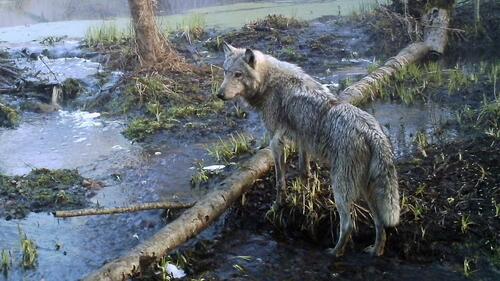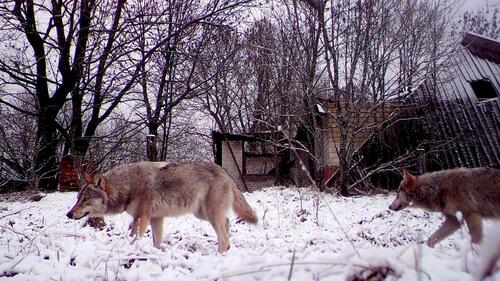
After nearly 40 years, mutated wolves roaming the deserted streets of the Chernobyl Exclusion Zone (CEZ) appear to have developed cancer resistance, according to Princeton evolutionary biologist and ecotoxologist, Cara Love - who has been studying how the Chernobyl wolves have survived for generations while facing exposure to radioactive particles, Sky News reports.
Roughly 100,000 people were evacuated from the 1,000 square-mile CEZ in 1986, and it has remained abandoned ever since, as radiation still poses a risk.
And with no humans around, wildlife such as wolves and horses has flourished.
In 2014, Love and a team of researchers visited the CEZ, and attached radio collars to the wolves in order to track them. She said they were able to obtain "real-time measurements of where [the wolves] are and how much [radiation] they are exposed to."

What's more, after taking blood samples, the team discovered that the wolves were exposed to upwards of 11.28 millirem of radiation daily for their entire lives - more than 6x the legal safety limit for a human. Love found that the wolves' immune systems displayed similar properties to cancer patients undergoing radiation treatment - including specific parts of the animals' genetic information that appears resilient to increased cancer risk.
A lot of research in humans has found mutations that increase cancer risk - with the presence of the variant BRCA gene making it more likely a woman might develop breast or ovarian cancer, for example.
But Ms Love's work has sought to identify protective mutations that increase the odds of surviving cancer. -Sky
Love presented her findings at the annual meeting of the Society of Integrative and Comparative Biology in Seattle, Washington, last month.
After nearly 40 years, mutated wolves roaming the deserted streets of the Chernobyl Exclusion Zone (CEZ) appear to have developed cancer resistance, according to Princeton evolutionary biologist and ecotoxologist, Cara Love – who has been studying how the Chernobyl wolves have survived for generations while facing exposure to radioactive particles, Sky News reports.
Roughly 100,000 people were evacuated from the 1,000 square-mile CEZ in 1986, and it has remained abandoned ever since, as radiation still poses a risk.
And with no humans around, wildlife such as wolves and horses has flourished.
In 2014, Love and a team of researchers visited the CEZ, and attached radio collars to the wolves in order to track them. She said they were able to obtain “real-time measurements of where [the wolves] are and how much [radiation] they are exposed to.”

What’s more, after taking blood samples, the team discovered that the wolves were exposed to upwards of 11.28 millirem of radiation daily for their entire lives – more than 6x the legal safety limit for a human. Love found that the wolves’ immune systems displayed similar properties to cancer patients undergoing radiation treatment – including specific parts of the animals’ genetic information that appears resilient to increased cancer risk.
A lot of research in humans has found mutations that increase cancer risk – with the presence of the variant BRCA gene making it more likely a woman might develop breast or ovarian cancer, for example.
But Ms Love’s work has sought to identify protective mutations that increase the odds of surviving cancer. -Sky
Love presented her findings at the annual meeting of the Society of Integrative and Comparative Biology in Seattle, Washington, last month.
Loading…





